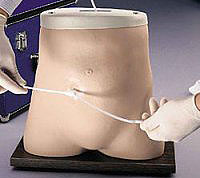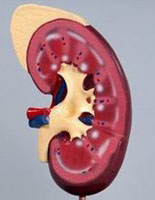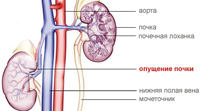There are two methods of dialysis - hemodialysis and peritoneal (peritoneal) dialysis. What they mean? What's better?
Content
Two methods of dialysis
 The main methods of treatment are two: hemodialysis (GD) and peritoneal dialysis (PADD). Both methods exist no longer than a decade.
The main methods of treatment are two: hemodialysis (GD) and peritoneal dialysis (PADD). Both methods exist no longer than a decade.
The hemodialysis method is based on blood purification using the device «Artificial kidney». Blood is passed through a special membrane and is thus cleaned by harmful substances that can no longer be withdrawn by their patient's kidneys. The hemodialysis procedure lasts about four hours and is usually carried out three times a week. I can not miss the procedure, because when the program is violated (and it is selected to each individual) treatment becomes ineffective.
The peritoneal dialysis method is based on the ability of the peritoneum (the thin shell, the abdominal cavity and covering the organs contained in it) to serve as a semi-permeable membrane, water and solids dissolved in it can be moved through it. With the help of a small operation in the abdominal cavity, a special conductor is installed (catheter), through which the cleansing solution will flow. The solution is left for several hours, during this time there is an intense exchange between it and the blood of the patient: harmful substances and excess water penetrate the blood through the peritoneum into a special solution and are deleted with it at the end of the procedure.
The inconvenience consists only that the substitution of the solution will have to be carried out 4–5 times a day daily, otherwise the treatment will be ineffective. One such procedure takes 25–30 minutes. Thus, the patient spends on its treatment 2–2.5 hours a day. People in need of dialysis, as a rule, train the rules for circulation of the catheter, independently conducting the exchange procedures, provide the necessary amount of solution, after which the treatment continues at home.
Pros and cons of dialysis
 Hemodiliz does not require the active participation of the patient, and the days of the patient should not be accepted into the days from sessions. But with peritoneal dialysis, it is not necessary to attend the hospital several times a week, you can work in the usual for most graphics and even leave for some time for the city or on a business trip.
Hemodiliz does not require the active participation of the patient, and the days of the patient should not be accepted into the days from sessions. But with peritoneal dialysis, it is not necessary to attend the hospital several times a week, you can work in the usual for most graphics and even leave for some time for the city or on a business trip.
But if you receive treatment with peritonial dialysis, then there should be good housing conditions, allowing to be treated at home, scrupulously comply with the rules of hygiene, to be very disciplined and at the same time able to do without assistance.
There are also some medical contraindications to each of the methods. The presence of severe vascular diseases, diabetes often leads to complications in the treatment of hemodialysis. On the other hand, previously transferred operations on the abdominal cavity, severe inflammatory bowel diseases or other abdominal organs, high weight, the presence of hernia, serious impairment of vision and some other concomitant circumstances often do not allow treatment of peritoneal dialysis.









